The Jewish Traveler
Feature
Tiberias
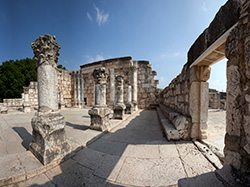
Stones and water define Tiberias. This northern Israeli city stretches along the shores of Lake Kinneret, whose misty, shimmering waters inspired the 20th-century Zionist poet Rachel to ask whether, perhaps, it was but a dream. And for centuries the area’s many hot springs have drawn visitors in search of healing.
The city is a study in black and white, its older structures and ancient walls made of basalt, a black volcanic stone, and the houses trimmed with white limestone. Even new buildings incorporate black stone, mimicking the basalt.
Because of a tradition that the Redemption would begin in Tiberias, it became a prime place to be buried. It was also one of the four “holy cities” in the Land of Israel—a main center of Jewish life after the Ottoman conquest in 1516 and an important point on the trade route to Damascus.
Old graves have long been a magnet for pilgrims and today are good business: Bus after bus disgorges blessing-seekers at the tombs of the righteous. So many graves underlie the city that rabbis have had to work overtime to find solutions to allow modern Tiberias to grow.
On the lakeshore Allon Promenade, however, and elsewhere in the old city, vacationers are clearly focused on the delights of this world, enjoying the lake’s bounty and its mysterious aura.
History
From the start, Tiberias was built over graves. In 18 C.E., Herod Antipas, the son of Herod the Great, inaugurated his new capital erected over the biblical Rakkath, naming it in honor of the emperor Tiberias. Built as a Hellenistic city with a palace at its highest point, Tiberias became the most important city on the lake by 66. Most of the residents were Jewish fishermen.
In 67, the wealthier population split from the Zealots and surrendered to the Romans. After the destruction of the Temple, many of Jerusalem’s Jewish religious academies and the Sanhedrin moved to Tiberias, making it the new Jewish capital. In this city the so-called Jerusalem Talmud was composed.
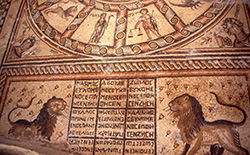
After the Arab conquest in 636, Jerusalem was again the Jewish capital, but Jews remained in Tiberias, which became a center of tapestry and textile manufacturing. In the ensuing centuries, the masoretes there—Karaite scribes and scholars—compiled a system that set the pronunciation, divisions and cantillation of the Bible. Modern texts follow the 10th-century text of the masorete Rabbi Aaron ben Moses ben Asher.
Only about 50 Jewish families lived in the city under the Crusaders, from the 12th to the 13th centuries. But in the 16th century, when thousands of Sefardic Jews settled in Ottoman Palestine, Tiberias again became a center of spiritual and economic activity.
Two extremely wealthy and influential Jews, Doña Gracia Mendes and her nephew Don Joseph Nasi, set out to rebuild the city as a Jewish commonwealth that would be a center for silk-making and a refuge for persecuted Jews from the papal states. The plan fell through when the Ottomans went to war with the Republic of Venice.
A group of Hasidim who arrived in 1777 helped revive the Jewish community, but a violent earthquake in 1837 killed many inhabitants (including as many as 1,000 Jews). By 1839, there were only 600 Jews.
Later in the 19th century, a modern Jewish community was established, serving as the center of new communities founded in eastern Lower Galilee in the beginning of the 20th century. In 1920, construction began on a new neighborhood, Kiryat Shmuel, on the slope above the old city. That year, too, the hot springs became a Jewish concession. In 1922, Tiberias had nearly 4,500 Jews (of a total population of nearly 7,000). Despite historically peaceful relations between the city’s Jews and Arabs, during the Arab riots of 1936 to 1939, more than 30 Jews were killed.
During the War of Independence, Arab-Jewish fighting in the city ended in a brief truce, then resumed. On the night of April 16, 1948, Jewish soldiers attacked the old city, demanding that the Arabs surrender. The 4,000 Arab inhabitants decided to leave the city, with British help. Tiberias was the first Arab-Jewish city to fall to the Jews.
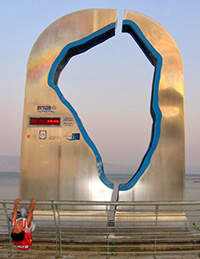
Community
Tiberias, which now has some 42,000 residents, has absorbed immigrants from Morocco, Tunisia, the former Soviet Union, South America and Ethiopia. About five percent of the residents are English speakers, some of them long-time residents. Most synagogues follow the Sefardic or Mizrahic rite, and there are many small yeshivas. Most jobs are in the tourism industry, though fishing is still important. And whereas the old city is about 700 feet below sea level, the newer sections are on the lakeside mountain slope well above sea level.
Sights
As the main source of Israel’s fresh water, Lake Kinneret is the focus of national attention and its level is often in the news. A sculptural representation of the lake at the southern end of the Allon Promenade allows a three-dimensional view of the water level.
Tiberias has long been a pilgrimage center promising healing of the body and the soul. For the ultimate in relaxation, soak in the indoor and outdoor mineral pools of Hamei Tveriya (Tiberias hot springs) or try the spa (with 90 massage rooms), saunas, fitness center and picnic area there. Two hotels offer free admission and transportation to Hamei Tveriya (Eliezer Kaplan Blvd; 011-972-4-672-8580).
For a more spiritual approach to healing, Tiberias offers a variety of graves attributed to righteous Jews. Opposite the hot springs stands the elaborate, blue-domed tomb complex of Rabbi Meir Baal Haness (Rabbi Meir the Miracle Worker), one of the greatest talmudic sages in the second century C.E. He asked to be buried upright to await the Redemption and greet the Messiah. The miracle in question was the rescue, with divine intervention, of his sister-in-law from captivity in a Roman brothel. The site includes synagogues and yeshivas.
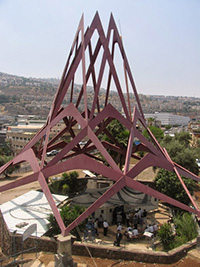
Farther north is the popular tomb of Maimonides, the great medieval scholar, philosopher and court physician who died in Egypt in 1209. According to tradition, he was buried in Tiberias. Ironically, he himself opposed pilgrimage to tombs.
A large, flamelike red metal pergola made of triangular sections hovers over the tomb area, which also contains the tombs of other luminaries, including Rabbi Yohanan Ben Zakkai. According to a sign at the site, the late Lubavitcher Rebbe Menachem Mendel Schneerson encouraged daily study by all Jews of Maimonides’s 14-volume Mishne Torah, a compendium of Jewish religious law.
Nearby is the three-story basalt Setton Family Hospitality Center, with a museum containing multimedia displays about the life and legacy of Maimonides, a hall for Jewish study and a presentation room for groups of up to 70 people. It is part of the Maimonides Heritage Center established in 2003 by Rabbi Yamin Levy of Great Neck (6 Hatanaim Street; 972-52-433-8976; book presentations in advance). The terraced garden surrounding the center contains herbs mentioned in Maimonides’s writing.
“By your merit, by your merit,” exclaims a woman entering the tomb complex of Rachel, the wife of Rabbi Akiva, who then places her hands on the tomb while praying. The tomb is housed in a simple basalt structure whose exterior looks more like a warehouse than it does a house of prayer.
Rachel is revered for forfeiting a life of comfort to marry a gifted shepherd and encouraging him to study Torah. Rabbi Meir Baal Haness was one of Rabbi Akiva’s 24,000 disciples. At Rachel’s tomb one may buy plastic bottles of water “from Rachel’s well” as well as a variety of amulets and souvenirs.
Other tombs include those of Rabbi Akiva and the Tombs of the Mothers—Yocheved (mother of Aaron), Miriam (Moses’ sister) and Zipporah (Moses’ wife)—a favorite site of women seeking to become pregnant.
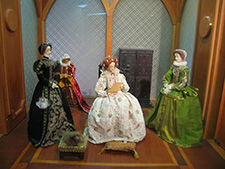
The life of Doña Gracia Mendes—probably the cleverest woman and certainly the richest of her time—is the stuff of novels. The exterior of Casa Doña Gracia, the fortress-like former shopping mall that houses a hotel named for the great lady as well as a museum about her, has but one clue to the riches inside: the old wooden entrance door. The lobby is furnished with antiques and designed to evoke 16th-century Spain and Portugal.
The museum has graceful dioramas with porcelain dolls depicting key moments in Doña Gracia’s life. Guided tours (for at least four people) end with participants dressing in period-style clothes for a souvenir photograph.
Casa Doña Gracia also serves as a center for empowering women and preserving Ladino songs; during the intermediate days of Sukkot it hosts an annual Doña Gracia festival, with Ladino music, culture and cuisine (3 Haprahim Street; 972-54-245-4053).
Archaeological remains of the city’s rich history, including parts of the ancient city walls, can be seen not only in designated archaeological parks but also in such places as the Allon Promenade and the sidewalk along Kaplan Boulevard. Roman remains extend south of the city, whereas the Crusader city extends north of the Roman town. Excavations of all periods from Roman times through to the Crusader period are still under way.
Hamat National Park, near the southern entrance to the city, contains the remains of the old city of Hamat, a suburb of ancient Tiberias that existed between the second century B.C.E. and the eighth century C.E. and had 17 healing springs.
The site had two synagogues, one built on top of the other. A magnificent mosaic floor with a depiction of the zodiac and with Greek and Aramaic inscriptions—the oldest synagogue mosaic found in Israel—was discovered in the earlier synagogue (third to fourth century) and is one of the attractions. The site also has an Ottoman period bathhouse and a shaded picnic area.
Also in the southern part of Tiberias near the lake is the recreation center Berko Park. The site contains the city’s monumental southern gate, built on a stream in the first century C.E., and parts of its broad main street—the Cardo—with diagonally laid stones. A bridge led from the gate to Hamat. The turnoff to the park is at a rotary on which stands a replica of a stone menora found in excavations.
The tourist information center in the center of the old city, near the Leonardo Plaza Hotel, doubles as an archaeological park. Housed in a vaulted basalt 12th-century Crusader fort, it is surrounded by a variety of artifacts, including the remains of a 6th-century synagogue and restored mosaics in which Jewish motifs, including a lulav and etrog, feature prominently.
On a path between al-Bahri Mosque and the Leonardo Plaza Hotel stands a small residential complex that is living testimony to Jewish settlement in Tiberias starting toward the end of the 18th century. A sign on the side of the building says it was the home of Rabbi Menachem Mendel of Vitebsk, who built it in 1786-1787. Nearby is a memorial to Tiberias locals who fell in Israel’s wars.
And near that is the Etz Haim Synagogue, founded in 1742 by Rabbi Haim Abulafia, who helped restore Jewish life in Tiberias.
Other Sights
Just before arriving in Tiberias from the south, stop in the cemetery of Kvutzat Kinneret to visit the graves of such luminaries as the poet Rachel, the writer Moses Hess, Labor Zionist ideologue Berl Katznelson, songwriter Naomi Shemer (composer of “Jerusalem of Gold”) and Avraham Hartzfeld, one of the “fathers” of agricultural settlement in the Land of Israel.
In antiquity, Jews lived around Lake Kinneret. Their settlements are named in the New Testament as sites where Jesus taught and are also pilgrimage sites for Christians.
Magdala, about six miles northwest of Tiberias, contains finds from the first century C.E., but nothing later, suggesting that it may have been destroyed during the first Jewish-Roman war. According to the New Testament, it was the birthplace of Mary Magdalene. The site contains the only synagogue in Galilee dating to the first century C.E. Among the finds is a large carved stone bearing a seven-branched menora. Excavations are continuing.
Capernaum, about six miles northeast of Tiberias, has an impressive late-fourth-century synagogue, called the White Synagogue because it is made of limestone, with Corinthian columns and Greek and Latin inscriptions. It is built on the remains of a synagogue in which, according to the New Testament, Jesus taught and healed a man.
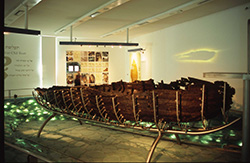
In Kibbutz Ginosar, 10 miles northeast of Tiberias, the Yigal Allon Center is faced with black stone, which contrasts with the bare concrete of its central section.
Allon (1918-1980), a member of Kibbutz Ginosar, was a Palmah commander, a general in the Israel Defense Forces and an Israeli politician remembered largely for his 1967 plan for a negotiated end to the occupation of the West Bank. The center (972-672-7700) commemorates Allon’s life and presents a history of the Palmah. It also contains the Man in the Galilee Museum, a spiral display space reminiscent of New York’s Guggenheim Museum, showing artifacts from all historical periods. Another exhibit is the Ancient Galilee Boat, a first-century C.E. vessel often referred to as the “Jesus boat,” which may have been a fishing boat or a ferry. It was discovered buried in the mud near the lakeshore and has been restored.
Personalities
Eleazar Kallir, the greatest, most prolific and one of the most influential of the early paytanim (liturgical poets), lived in Tiberias, perhaps as early as the sixth century C.E.
Aaron ben Moses ben Asher lived in Tiberias during the first half of the 10th century. Descended from a long line of masoretes, he was considered the most authoritative of the Tiberias masoretes.
Yossi Abulafia, a Tiberias-born Israeli author, graphic designer, cartoonist and illustrator of children’s books, has also illustrated books in English, for example, My Parents Think I’m Sleeping (HarperCollins), by Jack Prelutsky.
James Peter Richard “Jamie” Heaslip, captain of Ireland’s rugby team, was born in Tiberias while his father was there on duty with UNIFIL.
Israeli filmmakers and cousins Menahem Golan and Yoram Globus, who owned the company Cannon Group that made the 1985 film Runaway Train, were born in Tiberias.
Films, Book
Aviva, My Love (2006), directed by Shemi Zarhin, is set in Tiberias. Aviva works as a cook and is struggling to become a writer when she receives a dubious offer from her writing teacher.
In The World Is Funny (2012), also set in Tiberias, Zarhin again explores the theme of a woman working at a menial job while trying to succeed as a writer.
Milton Steinberg’s novel As a Driven Leaf (Behrman House), a dramatic exploration of the conflict between religious and pagan ideas, takes place in the Talmudic period and is set partly in Tiberias.
Recommendations
Balmy in early spring and late fall, Tiberias is also popular in winter and crowded with local visitors in summer. Besides water sports (including rowing) and the water park, visitors can enjoy jeep and ATV tours, horseback riding and boat trips to several points on the lakeshore.
Emily’s Boutique Hotel overlooks the lake and is within easy walking distance of the old city’s center and the Allon Promenade. It has an attractive plant-filled atrium and comfortable rooms (66 Hagalil; 972-4-664-7500).
Tiberias has an abundance of kosher restaurants, and even the nonkosher restaurants on the lakeshore serve a variety of fish.
Visitors will also find food for the soul, namely quality Israeli art at the Amdur Fine Gallery of Contemporary Art, run by Talya Polinger (10 Hakishon; 972-52-482-4967).
For a perfect conclusion to a day in Tiberias, drive around the lake or sail across it to Kibbutz Ein Gev and enjoy its restaurant’s signature meal of St. Peter’s fish, aka tilapia (972-4-665-8136). Gaze at the lake as the sun sets, dissolving the line between water and sky, and wonder, as Rachel did in her poem that has been set to haunting music, whether, perhaps, it has all been but a wonderful dream.










 Facebook
Facebook Instagram
Instagram Twitter
Twitter
Agnes Holland says
“Allon … his 1967 plan for a negotiated end to the occupation of the West Bank.” A Jewish publication should not spread the canard of “occupation” of the disputed territories, meaning that of no-man’s lands. I am sure, the author could have found a better description of the political realities of 1967.
Dorit says
Thanks for this Inspiring article on Tiberius
I’ve been here a month attempting Aliyah and had no idea of what I’ve been living in.
Great info to go exploring now..
Baruch haShem